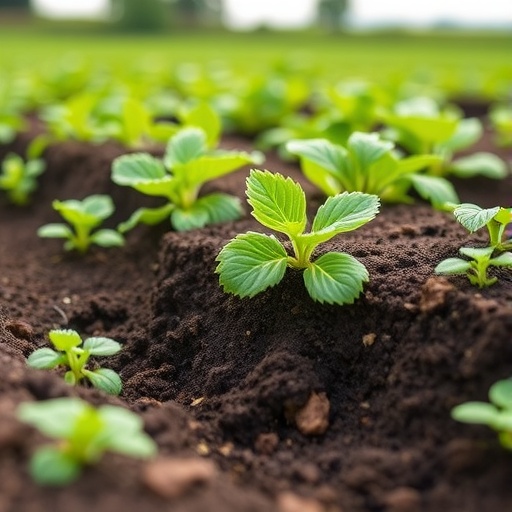Soil, often overlooked beneath the tapestry of agricultural landscapes, serves as the foundational substrate that supports terrestrial life and global food production. A pioneering study by Carswell and colleagues, recently published in npj Sustainable Agriculture, has illuminated how current agricultural practices are not merely altering soil composition but fundamentally reshaping the intricate feedback loops that maintain soil resilience. This revelation carries profound implications for the sustainability of farming systems worldwide, potentially threatening the very stability of ecosystems that humanity depends upon.
At the heart of this investigation lies the concept of soil resilience—the capacity of soil to resist and recover from disturbances such as erosion, compaction, nutrient depletion, and shifts in microbial communities. Soils are dynamic environments, hosting diverse biological and chemical interactions that facilitate nutrient cycling, water retention, and structural integrity. The study emphasizes that resilience is not a static trait but a complex property governed by feedback systems operating at multiple scales, from microscopic microbes to landscape-wide nutrient flows.
Agricultural intensification, characterized by monocultures, excessive tillage, and heavy reliance on synthetic fertilizers and pesticides, has accelerated in recent decades to meet global food demands. While these practices have indeed boosted short-term yields, Carswell et al. reveal that they may inadvertently destabilize soil feedback loops. The data illustrate how such management approaches can suppress beneficial microbial communities and alter soil organic matter turnover, fundamentally impairing the biotic mechanisms that underpin nutrient replenishment and soil structure stabilization.
One striking finding of the research is the identification of positive and negative feedback mechanisms in soils—cycles where certain practices reinforce either soil degradation or regeneration pathways. For example, conventional tillage disrupts soil aggregates and microbial habitats, leading to the depletion of organic carbon pools. This loss diminishes microbial activity, which in turn further reduces organic matter formation, creating a downward spiral of degradation. Conversely, systems that incorporate crop rotations and reduced tillage foster feedbacks that enhance microbial diversity and organic matter accrual, promoting resilience.
The scientists employed a sophisticated modeling framework integrating empirical soil data with ecosystem process models to forecast long-term impacts of different agricultural regimes. This approach enabled them to simulate how feedback loops evolve under varying management strategies and environmental stressors such as drought. Their simulations predict that without intervention, current intensive practices could push many soils into alternative degraded stable states, from which recovery is exceedingly difficult and costly.
Fundamentally, the research challenges traditional paradigms that focus on isolated parameters such as nutrient content or soil pH by highlighting the systemic nature of soil health. The feedback loop perspective underscores that soil is not merely a resource to be extracted but a complex living system requiring careful stewardship. The degradation of these feedbacks not only threatens soil productivity but also impairs functions essential for carbon sequestration and climate mitigation.
Furthermore, the authors spotlight the critical role of microbial networks in sustaining soil feedback loops. Soil microorganisms drive decomposition, nutrient mineralization, and symbiotic relationships with plants, thereby regulating key ecosystem functions. Disturbances such as chemical inputs and mechanical soil disruption can cause microbial community shifts towards less beneficial taxa, effectively breaking regeneration loops and reducing soil resilience.
This work also surfaces socio-economic dimensions, as the resilience of soil influences farmer livelihoods and food security. Degraded soils demand increasingly intensive inputs to sustain yields, inadvertently reinforcing damaging feedback cycles. The researchers advocate for policy frameworks that incentivize regenerative agricultural practices capable of restoring feedback loops and thus soil health. Such measures could include support for cover cropping, organic amendments, agroforestry, and minimum tillage techniques.
Technological advancements provide hope for monitoring and manipulating soil feedback mechanisms proactively. Emerging tools such as metagenomic sequencing, remote sensing, and bioinformatics enable detailed characterization of soil biota and processes. Coupled with precision agriculture, these techniques could empower farmers to tailor management for maintaining or enhancing soil feedbacks, thereby balancing productivity with sustainability.
The study’s findings resonate particularly in the context of climate change, as healthy and resilient soils offer a bulwark against extreme weather events and shifting rainfall patterns. Resilient feedback loops facilitate rapid recovery from drought-induced stress by maintaining moisture retention and nutrient cycling. Conversely, soils with compromised feedback networks exacerbate vulnerabilities, leading to crop failure and land degradation.
Notably, this work calls for interdisciplinary collaboration at the nexus of soil science, ecology, agronomy, and socio-economics to holistically address feedback loop management. By marrying empirical research with ecosystem modeling and stakeholder engagement, the path toward sustainable soil stewardship can be more firmly grounded in the feedback dynamics elucidated by this groundbreaking study.
In conclusion, Carswell et al.’s research represents a paradigm shift in understanding how agricultural practices influence soil resilience through feedback mechanisms. It provides compelling evidence that soil health depends as much on preserving these feedback loops as on traditional soil properties. As global pressure on arable land intensifies, integrating these insights into farm management and policy could be pivotal in reversing soil degradation trends and ensuring long-term agricultural sustainability.
This study not only advances scientific knowledge but also delivers a clear message to practitioners: soil is a living system, interconnected through feedback loops that require mindful management. Disrupting these loops for short-term gain risks undermining the ecosystem services soils provide, with cascading effects on food systems, climate, and biodiversity. Transitioning towards agricultural systems that nurture and restore soil feedbacks emerges as an urgent priority for a sustainable and resilient future.
Subject of Research: The impact of agricultural practices on soil resilience, focusing on how these practices alter soil feedback loops.
Article Title: Agricultural practices can threaten soil resilience through changing feedback loops
Article References:
Carswell, A.M., Willcock, S., Blackwell, M.S.A. et al. Agricultural practices can threaten soil resilience through changing feedback loops. npj Sustain. Agric. 3, 56 (2025). https://doi.org/10.1038/s44264-025-00098-6
Image Credits: AI Generated




